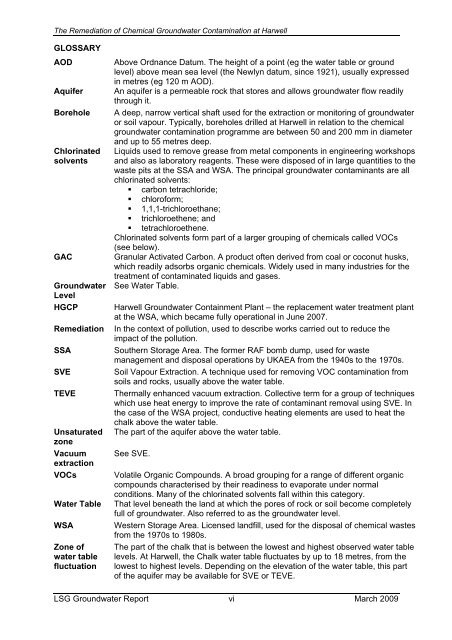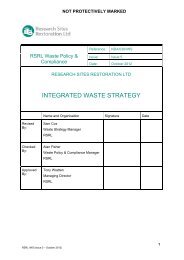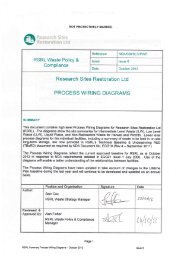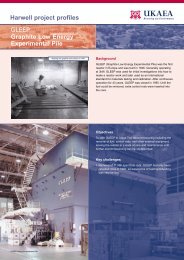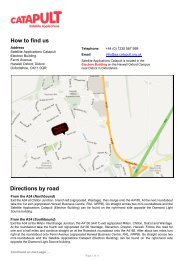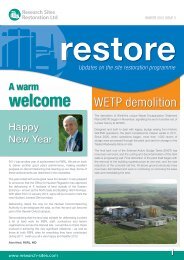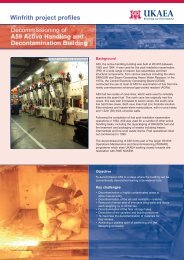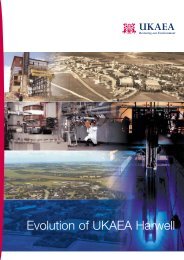The Remediation of Chemical Groundwater Contamination at Harwell
The Remediation of Chemical Groundwater Contamination at Harwell
The Remediation of Chemical Groundwater Contamination at Harwell
Create successful ePaper yourself
Turn your PDF publications into a flip-book with our unique Google optimized e-Paper software.
<strong>The</strong> <strong>Remedi<strong>at</strong>ion</strong> <strong>of</strong> <strong>Chemical</strong> <strong>Groundw<strong>at</strong>er</strong> <strong>Contamin<strong>at</strong>ion</strong> <strong>at</strong> <strong>Harwell</strong>GLOSSARYAODAquiferBoreholeChlorin<strong>at</strong>edsolventsGAC<strong>Groundw<strong>at</strong>er</strong>LevelHGCP<strong>Remedi<strong>at</strong>ion</strong>SSASVETEVEUns<strong>at</strong>ur<strong>at</strong>edzoneVacuumextractionVOCsW<strong>at</strong>er TableWSAZone <strong>of</strong>w<strong>at</strong>er tablefluctu<strong>at</strong>ionAbove Ordnance D<strong>at</strong>um. <strong>The</strong> height <strong>of</strong> a point (eg the w<strong>at</strong>er table or groundlevel) above mean sea level (the Newlyn d<strong>at</strong>um, since 1921), usually expressedin metres (eg 120 m AOD).An aquifer is a permeable rock th<strong>at</strong> stores and allows groundw<strong>at</strong>er flow readilythrough it.A deep, narrow vertical shaft used for the extraction or monitoring <strong>of</strong> groundw<strong>at</strong>eror soil vapour. Typically, boreholes drilled <strong>at</strong> <strong>Harwell</strong> in rel<strong>at</strong>ion to the chemicalgroundw<strong>at</strong>er contamin<strong>at</strong>ion programme are between 50 and 200 mm in diameterand up to 55 metres deep.Liquids used to remove grease from metal components in engineering workshopsand also as labor<strong>at</strong>ory reagents. <strong>The</strong>se were disposed <strong>of</strong> in large quantities to thewaste pits <strong>at</strong> the SSA and WSA. <strong>The</strong> principal groundw<strong>at</strong>er contaminants are allchlorin<strong>at</strong>ed solvents:• carbon tetrachloride;• chlor<strong>of</strong>orm;• 1,1,1-trichloroethane;• trichloroethene; and• tetrachloroethene.Chlorin<strong>at</strong>ed solvents form part <strong>of</strong> a larger grouping <strong>of</strong> chemicals called VOCs(see below).Granular Activ<strong>at</strong>ed Carbon. A product <strong>of</strong>ten derived from coal or coconut husks,which readily adsorbs organic chemicals. Widely used in many industries for thetre<strong>at</strong>ment <strong>of</strong> contamin<strong>at</strong>ed liquids and gases.See W<strong>at</strong>er Table.<strong>Harwell</strong> <strong>Groundw<strong>at</strong>er</strong> Containment Plant – the replacement w<strong>at</strong>er tre<strong>at</strong>ment plant<strong>at</strong> the WSA, which became fully oper<strong>at</strong>ional in June 2007.In the context <strong>of</strong> pollution, used to describe works carried out to reduce theimpact <strong>of</strong> the pollution.Southern Storage Area. <strong>The</strong> former RAF bomb dump, used for wastemanagement and disposal oper<strong>at</strong>ions by UKAEA from the 1940s to the 1970s.Soil Vapour Extraction. A technique used for removing VOC contamin<strong>at</strong>ion fromsoils and rocks, usually above the w<strong>at</strong>er table.<strong>The</strong>rmally enhanced vacuum extraction. Collective term for a group <strong>of</strong> techniqueswhich use he<strong>at</strong> energy to improve the r<strong>at</strong>e <strong>of</strong> contaminant removal using SVE. Inthe case <strong>of</strong> the WSA project, conductive he<strong>at</strong>ing elements are used to he<strong>at</strong> thechalk above the w<strong>at</strong>er table.<strong>The</strong> part <strong>of</strong> the aquifer above the w<strong>at</strong>er table.See SVE.Vol<strong>at</strong>ile Organic Compounds. A broad grouping for a range <strong>of</strong> different organiccompounds characterised by their readiness to evapor<strong>at</strong>e under normalconditions. Many <strong>of</strong> the chlorin<strong>at</strong>ed solvents fall within this c<strong>at</strong>egory.Th<strong>at</strong> level bene<strong>at</strong>h the land <strong>at</strong> which the pores <strong>of</strong> rock or soil become completelyfull <strong>of</strong> groundw<strong>at</strong>er. Also referred to as the groundw<strong>at</strong>er level.Western Storage Area. Licensed landfill, used for the disposal <strong>of</strong> chemical wastesfrom the 1970s to 1980s.<strong>The</strong> part <strong>of</strong> the chalk th<strong>at</strong> is between the lowest and highest observed w<strong>at</strong>er tablelevels. At <strong>Harwell</strong>, the Chalk w<strong>at</strong>er table fluctu<strong>at</strong>es by up to 18 metres, from thelowest to highest levels. Depending on the elev<strong>at</strong>ion <strong>of</strong> the w<strong>at</strong>er table, this part<strong>of</strong> the aquifer may be available for SVE or TEVE.LSG <strong>Groundw<strong>at</strong>er</strong> Report vi March 2009


